The Budget delivered tonight by Treasurer Scott Morrison was a fairly dull affair with most of the measures leaked beforehand, therefore ensuring there were no major surprises. There is not a lot in here to upset anybody, but also nothing to ‘wow’ the electorate either (and that’s a good thing).
Budget deficit to disappear, if you believe the forecasts
On the finances first, the Budget has forecast that the Budget deficit will be $18.2 billion in 2017-18, falling to $14.5 billion in 2019-19, with the deficit then falling to $2.2 billion in 2019-20, before turning to a surplus of $11.0 billion in 2020-21 and $16.6 billion in 2021-22.
Net debt is projected to peak at 18.6% of GDP in 2017-18 before falling to 3.8% of GDP in the medium term by 2028-29. In a similar vein, gross debt will peak during 2019-20 at less than 30% of GDP.
As flagged in the run-up to this Budget, the Government has locked in its tax-to-GDP ceiling of 23.9%, whereas Government spending is projected to fall to 24.7% of GDP over the forward estimates, which is below the 30 year average at 24.8%.
In his speech, Treasurer Morrison spruiked how this Government is paying down “Labor’s debt”, although the below chart begs to differ:
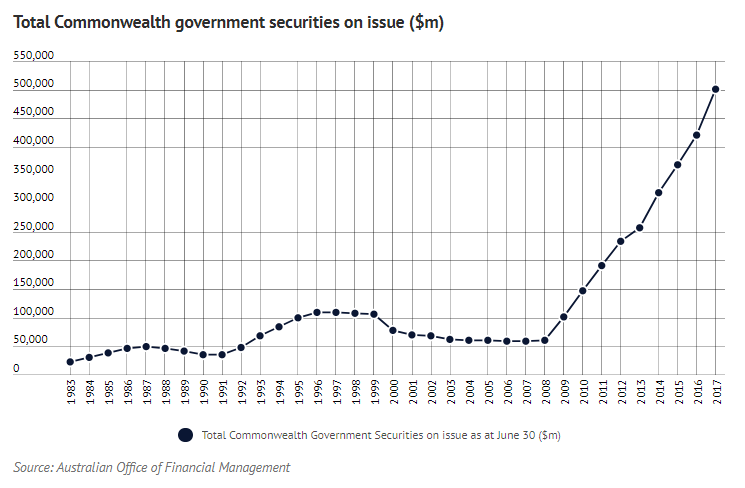
As always, these Budget projections should be taken with huge pinch of salt and considered of very low reliability, given Treasury’s abysmal history of forecasting tax revenues (see below charts).
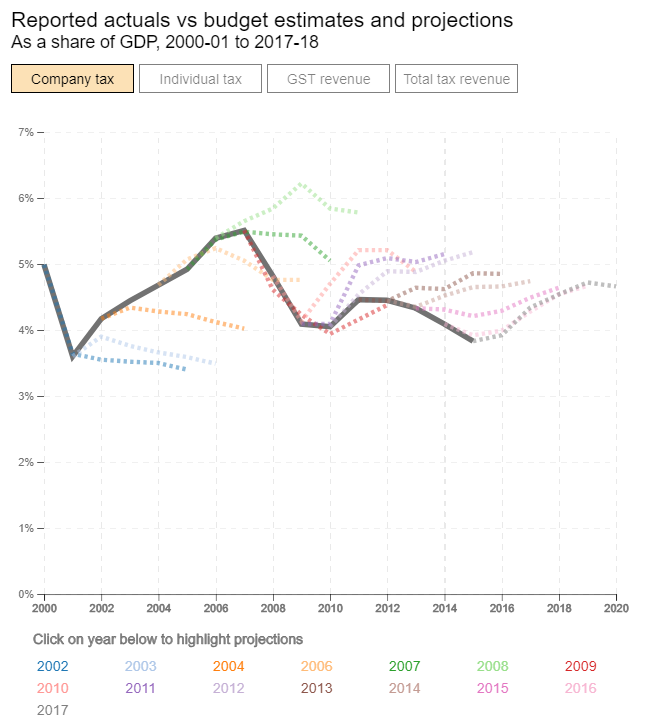
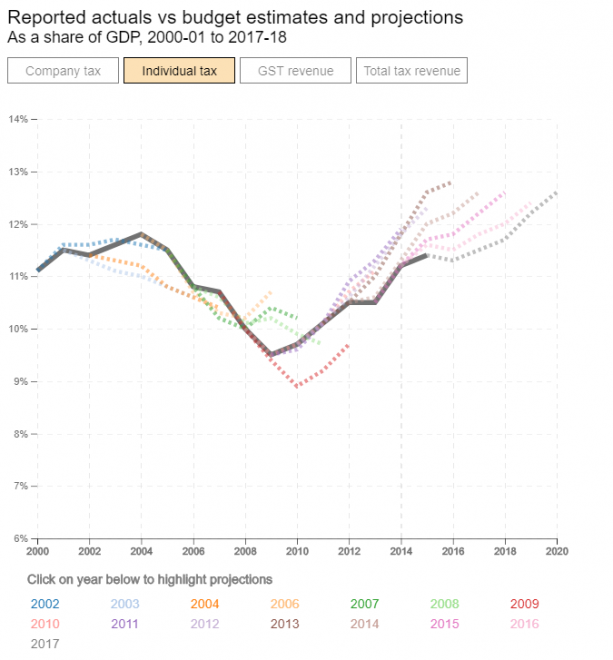
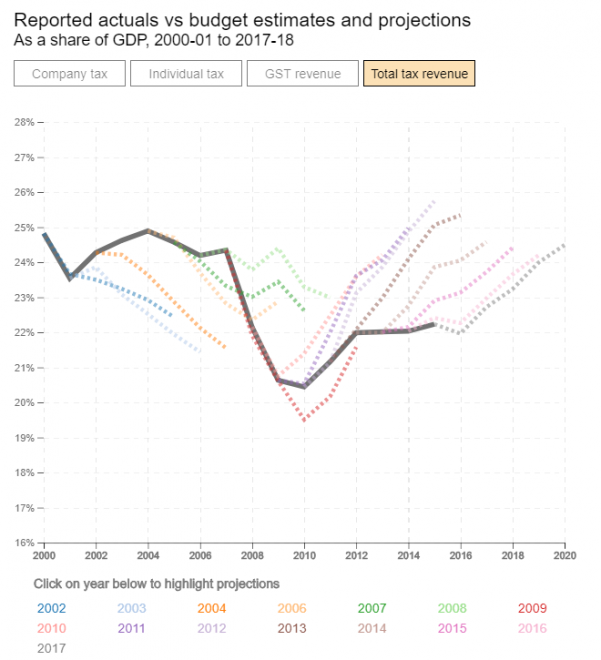
This Budget has been boosted significantly by a one-off windfall from higher commodity prices, and we expect these to retrace over the forward estimates, thus blowing a hole in the Budget forward estimates (Dave will write a detailed post later on the financials).
Tax cuts:
Turning to the main Budget measures, the talk of the town was the Government’s 7-year personal tax plan, which it intends to enshrine in legislation at a cost of $13.4 billion over the forward estimates. Under this plan:
- Permanent tax relief will be given to middle and lower income earners via an additional targeted tax offset through annual tax returns. Specifically:
- Those earning up to $37,000 and paying 19 cents in the dollar will have their tax reduced by up to $200 on what they have paid in tax.
- Those earning more than $37,000 and paying 32.5 cents in the dollar will see their tax reduced up to a maximum of $530 per year (impacting 4.4 million taxpayers).
- And for those earning above $90,000 the tax relief reduces to zero at just over $125,000.
- Bracket creep will be reduced over the forward estimates, via:
- From 1 July 2018, the threshold for the 37% marginal tax rate will be raised from $87,000 currently to $90,000 from 1 July 2018.
- In 2022-23, the $37,000 threshold will be lifted to $41,000 and the $90,000 threshold will be raised again to $120,000.
- In 2024-25, the 37% bracket will be abolished, whereas the top marginal tax rate threshold will be increased to $200,000 from $180,000.
These changes to the personal tax system will obviously make it flatter and less progressive.
Retirees a winner, unemployed forgotten:
Retirees are winners from this Budget, although most of the measures were flagged beforehand.
The Pension Loans Scheme (PLS) will be opened to all older Australians, including full rate pensioners and self-funded retirees, so they can boost their retirement income by up to $17,800 for a couple, without impacting on their eligibility for the pension or other benefits. MB supports extending the PLS, but only if it is accompanied by tightening the assets test for the Aged Pension (see Tuesday’s post here).
An expanded Pension Work Bonus will be implemented to allow pensioners to earn an extra $1,300 a year without reducing their pension payments, whereas the bonus will be extended to self-employed individuals who can now earn up to $7,800 per year.
The Government will increase the number of home care places for elderly Australians by 14,000 over 4 years at a cost of $1.6 billion, whereas $146 million will be provided to improve access to aged care services in rural, regional and remote Australia.
Sadly, there was no increase in the Newstart Allowance (the ‘dole’), thus the unemployed will be stuck living on a measly $40 a day.
Infrastructure still badly underfunded:
Last year’s rolling $75 billion infrastructure spending over 10-years has been maintained, although there will also be a $1 billion Urban Congestion Fund to support projects at a State level to fix pinch points and improve traffic flow, as well as a $3.5 billion Roads of Strategic Importance initiative to upgrade key freight routes.
As I noted in last year’s Budget, this level of infrastructure investment won’t be nearly enough to keep up with the 3.5 to 4.0 million population growth expected to be added over this 10-year period, nor backfill the infrastructure deficit that has accumulated over the past 15 years as Australia’s population has soared.
Remember, the Productivity Commission (PC) in 2013 estimated that total private and public investment requirements over the next half century will need to be more than 5-times the cumulative investment made over the last half century:
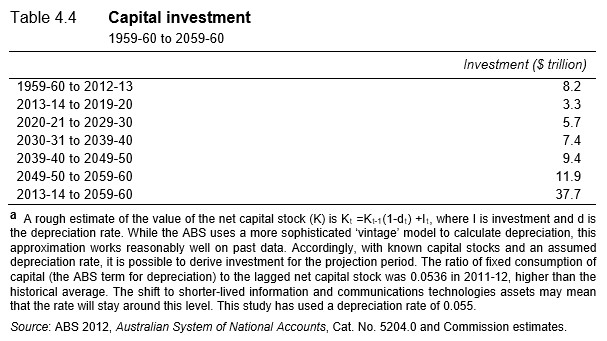
So, with the federal government wedded to its mass immigration ‘Big Australia’ policy, resident Australians’ living standards will continue to be crush-loaded, as they have been over the past 15 years.
Company tax cut zombie measures retained:
As expected, the Government has retained its plan to cut the company tax rate for larger companies to 25% from 30%, despite this measure highly unlikely to pass the Senate.
The instant asset write-off for businesses with a turnover up to $10 million for purchases of up to $20,000 has been retained, whereas an additional $250 million will be provided for the Skilling Australians Fund.
The R&D tax incentive will be better targeted to give more support to companies that invest a higher proportion of what they spend in R&D, over and above what they would do anyway. Enhanced integrity, enforcement and transparency arrangements will be implemented, saving taxpayers $2 billion over the next four years.
There will also be $500 million of pork for a Medical Research Future Fund so that Australia can become a world leader in genomic research.
And the Government will invest $2.4 billion in Australia’s public technology infrastructure, such as supercomputers, satellite imagery, GPS across Australia, upgrading the Bureau of Meteorology’s technology platform, a national space agency and artificial intelligence research.
Crackdown on multinational tax avoidance and black economy:
A Rudd Government loophole that gave foreign companies a tax break over Australian companies, by changing the tax treatment of stapled structures, will be closed.
Thin capitalisation rules to stop multinationals from manipulating how they account for debt, to reduce their tax liabilities, will be tightened.
Recommendations from the Black Economy Taskforce will be implemented targeting sectors where there is higher risk of under reporting of income, which is expected to reap $5.3 billion in additional revenue over four years. These measures include outlawing large cash payments of greater than $10,000 in the Australian economy.
Reaffirmed commitment to social programs:
The Budget reaffirms existing commitments to programs like the Gonski 2.0 needs-based school funding program, Medicare and the NDIS.
Initial Impressions:
After last year’s Labor-lite Budget, this one was as a fairly conservative affair, given it is the last before the next election.
The Government is clearly keeping some powder dry so that it can buy itself votes closer to the election date.

